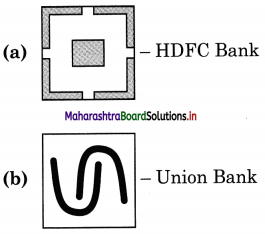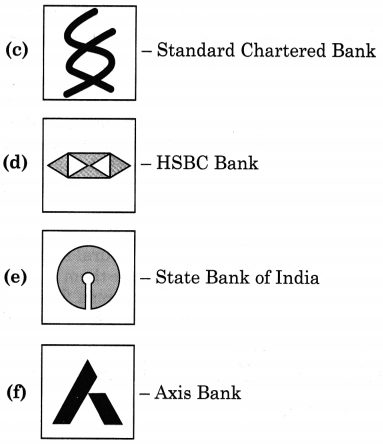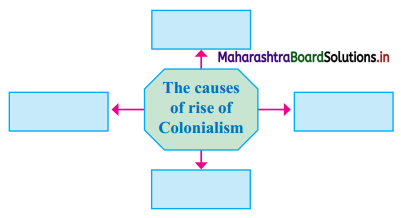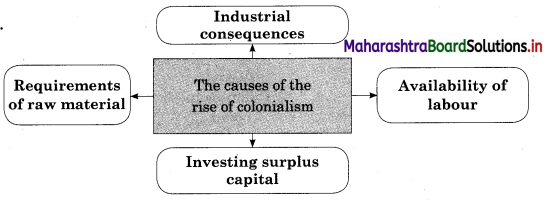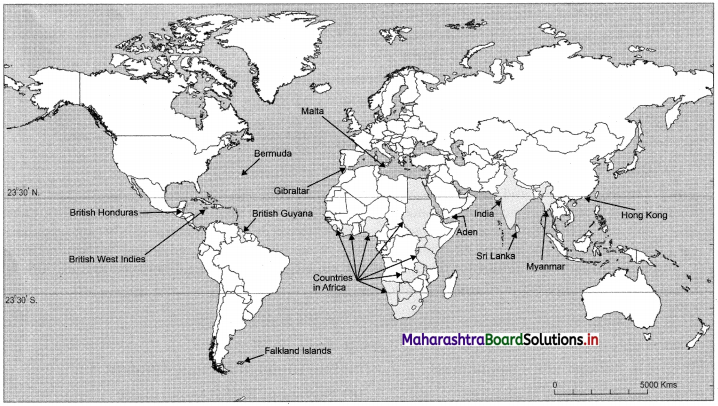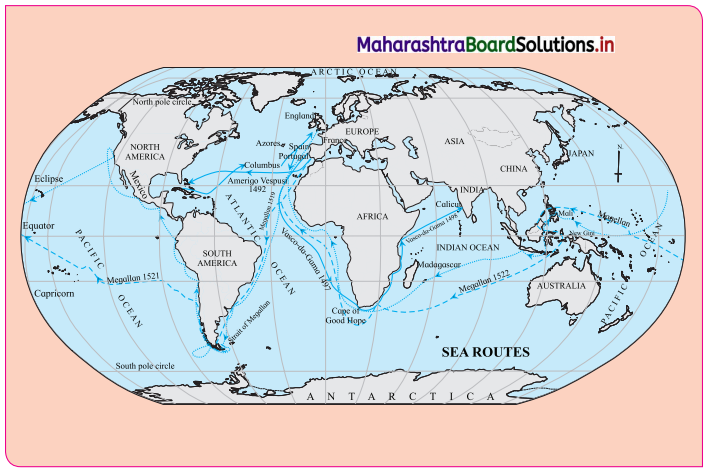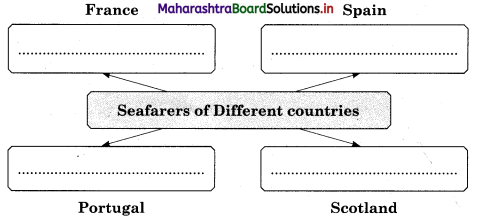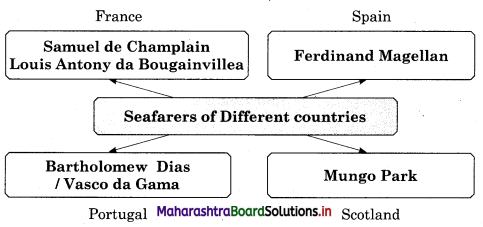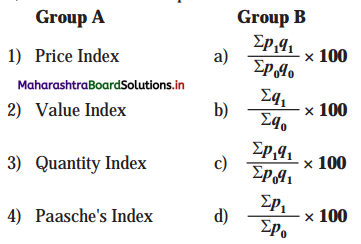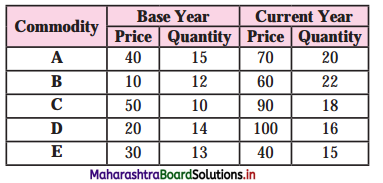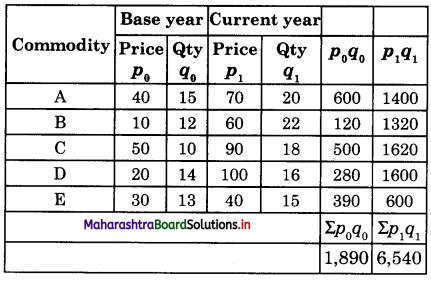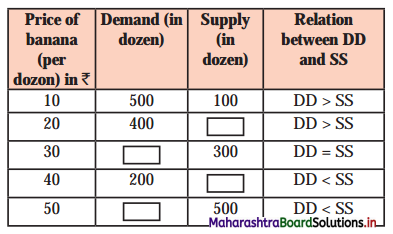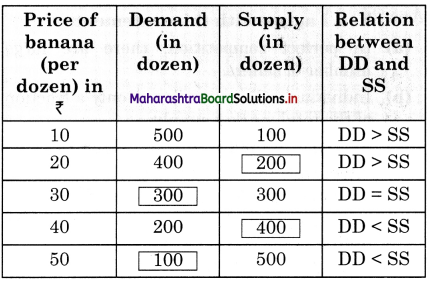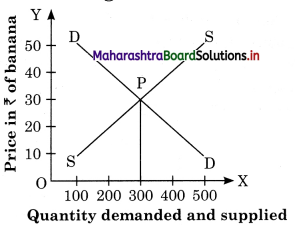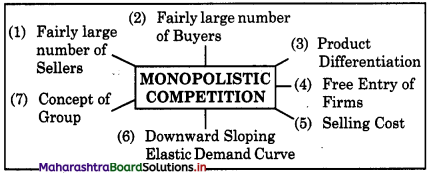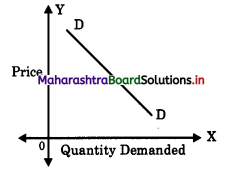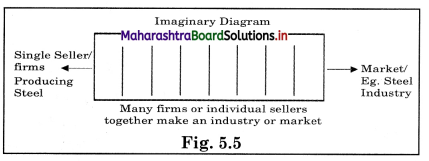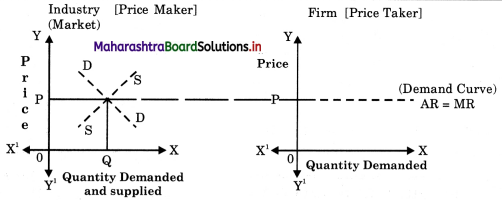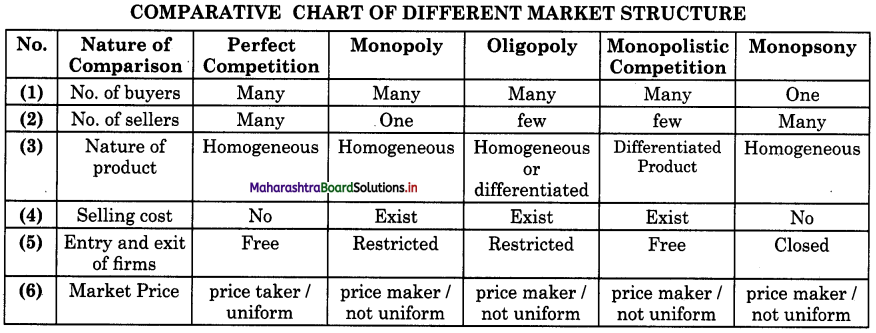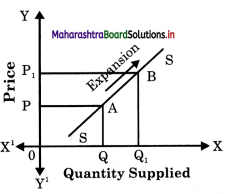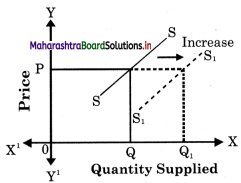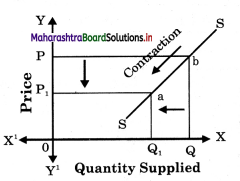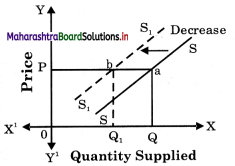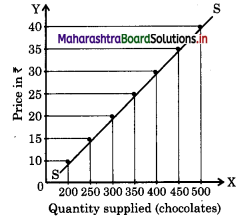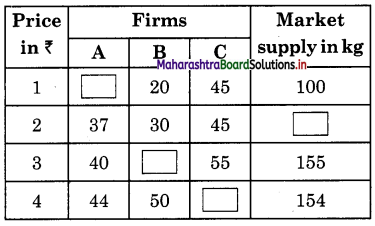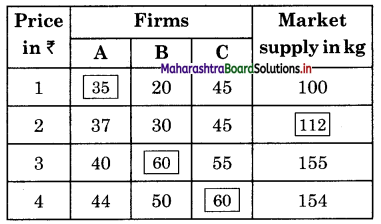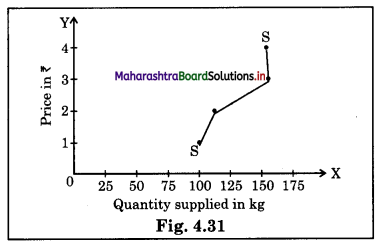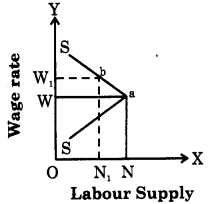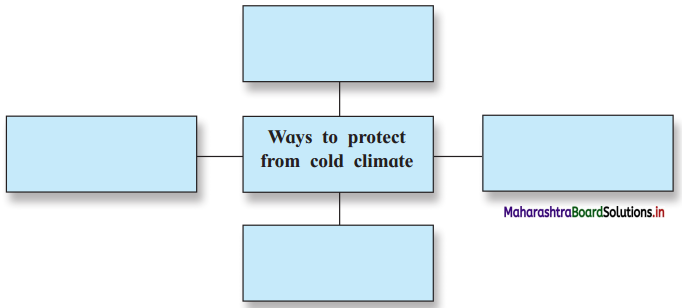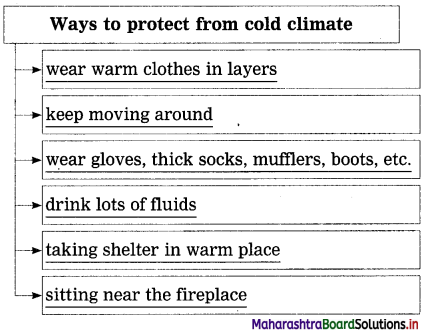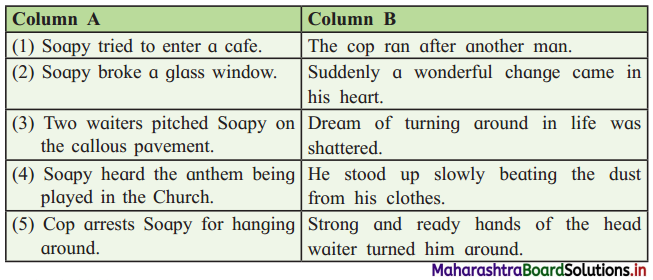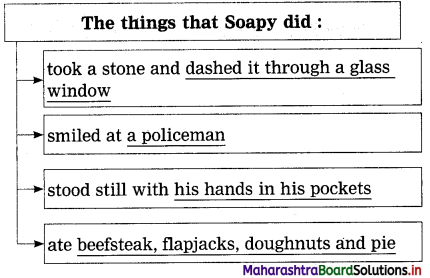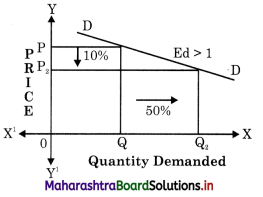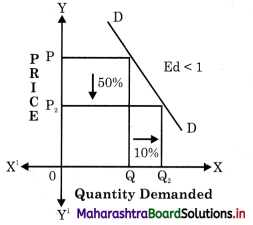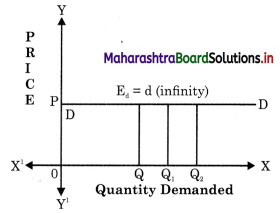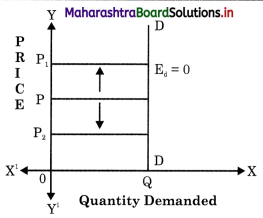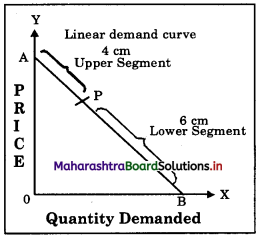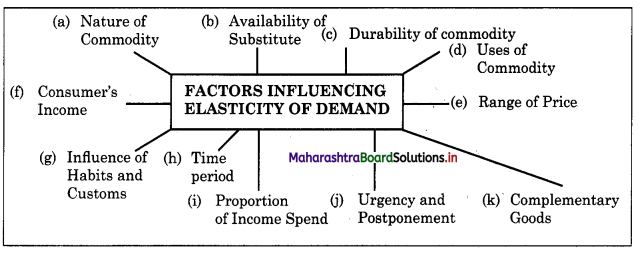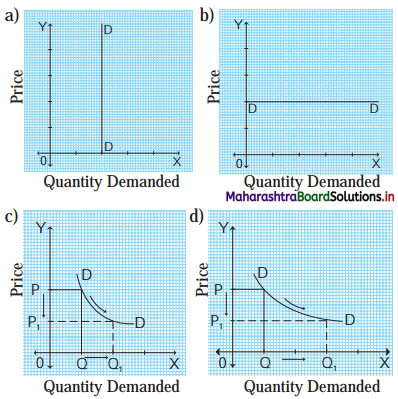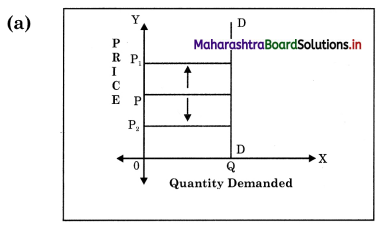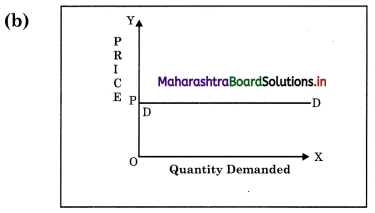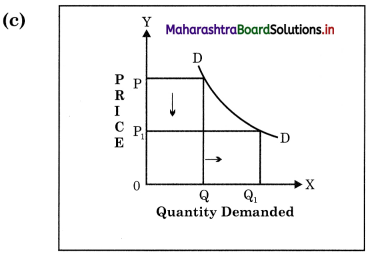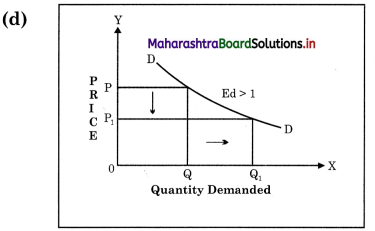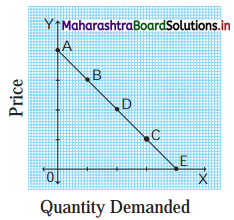Balbharti Maharashtra State Board Class 12 Economics Solutions Chapter 7 National Income Textbook Exercise Questions and Answers.
Maharashtra State Board Class 12 Economics Solutions Chapter 7 National Income
1. Complete the following statements:
Question 1.
While estimating national income, we include only value of final goods and services in order to
a) make computation easier
b) avoid double counting
c) maximize national welfare of the people
d) evaluate the total economic performance of a nation
Answer:
b) avoid double counting
Question 2.
NDP is obtained by
a) deducting depreciation from GNP
b) deducting depreciation from GDP
c) including depreciation in GDP
d) including depreciation in GNP
Answer:
b) deducting depreciation from GDP
![]()
Question 3.
In India, national income is estimated using
a) output method
b) income method
c) expenditure method
d) combination of output and income method
Answer:
d) combination of output and income method
2. Complete the Correlation:
1) ……………… :C+I+G+(X-M)::GNP:C+I+G + (X-M) + (R-P).
2) Output method : ……………… :: Income method : Factor cost method
3) Theoretical difficulty : Transfer payments :: ……………… : Valuation of Inventories
Answer:
- GDP
- Product / Inventory method
- Practical difficulty
3. Identify the incorrect pair:
a) National Income Committee — 1949
b) Financial year 1’ April to 31st March
c) Income method — National Income = Rent + Wages + Interest + Profit + Mixed income + Net Income from abroad
d) Expenditure method – National Income = Rent + Wages + Interest + Profit
Options:
1) a 2) b 3) c 4) d
Answer:
d) Expenditure method — National Income = Rent + Wages + Interest + Profit
4. Identify and Explain the following concepts:
Question 1.
Vrinda receives monthly pension of Rs.5,000/- from the State Government.
Answer:
Concept: Transfer payment.
Explanation : Pension is a part of money income earned by an employee during his service period with the entrepreneur.
Such income is paid by Government to an employee after his retiement so as to make employee survive during his retirement period.
Thus, transfer income is not included in National Income. It is just an government expenditure.
Question 2.
Viru kept aside 1oo kgs. out of 500 kgs. of wheat produced in his farm for his family.
Answer:
Concept: Production for self-consumption. Explanation : In above case, Viru’s total production is 500 kgs but he keep aside 100 kgs for his self consumption.
This 100 kg will not be shown by him as his income and hence it will not be included in national income accounting.
Such output kept for self consumption is called as theoretical difficulty in measurement of national income.
Question 3.
Sheetal purchased wheat flour for her bakery from the flour mill.
Answer:
Concept: Intermediate goods.
Explanation : In the above case, wheat flour is not the final product.
Wheat flour will be used by Sheetal to produce cake or pastry or biscuits which will be final product for her.
So, in above case wheat flour is considered j! (8) as intermediate goods. Intermediate goods are excluded while calculating NI by Final ( Ans. Goods approach method and included while calculating by Value Added approach method.
Question 4.
Shobha collected data regarding the money value of all final goods and services produced in the country for the financial year 2018-2019.
Answer:
Concept: National Income.
Explanation : National Income estimate ( measures the column of commodities and ) services turned out during a given period, counted without duplication.
NI is the macro concept. It is flow concept.
![]()
Question 5.
Rajendra has a total stock of 500 gel pens in his shop which includes 200 gel pens produced in the previous financial year.
Answer:
Concept: Flow Concept
Explanation : National Income accounting considers the production of goods and services in a current year. The production of previous year is ignored.
Thus, out of total inventory, of Mr Rajendra, only 300 pens will be taken into consideration while calculating NI for the current year.
5. Answer the following
Question 1.
Explain the two sector model of circular flow of national income.
OR
Explain the circular flow of National Income.
Answer:
The two sector economy consists of household J and business firm. The income is circulated between household and business firm. It is explained with the help of following diagram.
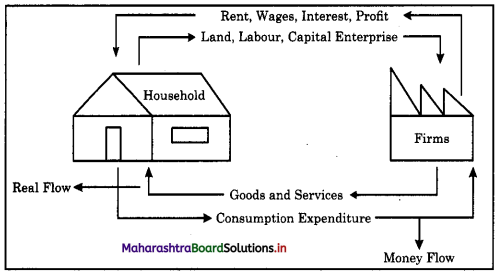
In every economy there is household sector on one hand and business firm on the other hand.
(A) Household is the basic consuming unit. It) centres around a family. Its main function j is to consume goods and services. Business firm is the basic producing unit. Its main function is to produce goods and services with the aim of maximising profits. When s the household supplies factor services (land, ^ labour, capital, enterprise to business firms, business firms supply goods and services to the household. This is known as Real Flow.
(B) In a money economy when the household supplies factor services, there is a flow of income from the business firm to the j household in form of rent, wages, interest and profit. This income comes from the firms to the household sector. The household ; sector uses this income to satisfy the wants. Therefore, there is a flow of consumption expenditure from the household to the business firms. The flow of factor payments from business sector to household sector and corresponding flow of consumption expenditure from household sector to business firms. This is known as Money Flow. Both the money flow and real flow should balance for the smooth functioning of the economy. If the money flow is greater j than real flow there would be inflation and if the money flow is less than the real flow there would be deflation.
![]()
(C) In the above diagram, the inner circle represents the Real flow and the outer circle represents the Money flow. There is circular and continuous flow of money income as production is a continuous activity due to never ending human wants. The circular J flow shows interdependence in the economy.
Question 2
Explain the importance of national income.
Answer:
National income data is very useful for various purposes. It is as follow :
- For the Economy : National income data are very important for macro economic analysis and performance of the economy.
- National Policies : National income gives the industrial policy, agricultural policy, export promotion policy etc.
- Economic Planning : The data of national income is very important tools for long term and short term economic planning e.g. planning for aggregate saving, investment, output, etc.
- Economic Research: The data of national income is very useful to the research students to study in detail how income is produced, how it is distributed, how much is spent, saved or taxed.
- Comparison of Standard of Living :
Because of national income, it is possible to do comparison between the standard of living of the people of different countries and home country. - Distribution of Income : The data of national income is very important to understand the disparities in the income of different sections of the society and to make the policies to reduce the disparities in income.
- Speed of Economic Growth : Because of national income, it is possible to know the trends or speed of the economic growth of our country in relation to previous years.
Question 3.
Explain the features of national income.
Answer:
(1) Flow Concept : National Income is the flow of goods and services produced in the economy during a year. The flow of goods takes place when there is production activity in the economy. It generates flow of income in the form of rent, wages, interest and profit.
(2) Avoid Double Counting: While estimating National Income we include only the value of final goods and services and not the value of intermediate goods or raw materials to avoid double counting.
(3) National Income is the net aggregate value : National Income includes net value of goods and services produced. It does not include depreciation cost. Depreciation is wear and tear of capital goods due to their continuous use in production.
(4) Transfer Income : Transfer Income in J the form of old age pension, lottery prize, scholarship, etc. are not to be included as they are received without contributing anything to the current national income.
(5) National Income is money valuation of goods: National Income is always expressed ( in money terms. Only those goods and services which are exchanged for money are included. Unpaid services like the service of housewife should not be included.
(6) National Income is calculated for one year : National Income is always expressed with reference to time period i.e. generally one financial year from 1st April to 31st March of every year.
(7) Net Income from Abroad: While estimating National Income net Income from abroad i.e. difference between exports and imports (X – M) as well as net income from foreign investment should be included (R – P).
(8) Macro Economic Concepts : National Income is a macro economic concepts as it is the aggregate income of the country. It includes the value of goods and services produced in the different sectors of the economy. National Income data present the (1) There are many theoretical difficulties picture of the performance of the economy in the measurement of National Income, during a given period of time.
(9) National Income is calculated at current and constant price: National Income when calculated at the prevailing market price it is called National Income at current price and when it is calculated at the base year price, it is called National Income at constant price
![]()
Question 4.
Explain the concept of Green GNP.
Answer:
The Green GNP is the measurement of the national income adjusted for degradation of environment.
E.g. The National Income for a current year is 8,000 units and the degradation of environment is 500 units, so Green GNP is ( 8000 – 500 = 7500 units.
The green GNP considers the environmental degradation or resource depletion.
It is defined as, “Green GNP is an indicator of sustainable use of natural environment and equitable distribution of benefits of development.”
The features of Green GNP are :
- Sustainable economic development means economic development without creating pollution or environmental degradation.
- The benefits of sustainable economic development should be equally distributed. In the long period of time it helps to promote economic welfare.
Green GNP = (Net fall in stock of natural capital + Pollution load)
6. State with reasons, whether you agree or disagree with the following statements:
Question 1.
There are many theoretical difficulties in the measurement of national income.
Answer:
Yes, I agree with this statement.
National income is a very broad concept and it is difficult to precisely define what exactly should be included and not to be included.
- Transfer payment: If it included in national income then there will be overestimation of NI. E.g. pension, gifts, unemployment allowances, etc. are excluded.
- Unpaid services : The value of unpaid services are not included in national income as they are not paid for. E.g. services of housewife.
- Illegal income : The income from illegal activities are not included in NI. E.g. black marketing, smuggling.
- Production kept for self-consumption :
It is not accounted for in the national income as such product does not enter the
Question 2.
Under output method, value added approach is used to avoid double counting.
Answer:
Yes, I agree with this statement.
- The value added approach is the difference between the value of final output and input at each stage of production.
- In this approach, the value added at each stage of production is considered.
- E.g.

- In the above example, value of groundnut with shell is ₹ 50, after removing shells value of groundnut is ₹ 80, after crushing groundnut value oil ₹ 120 and when oil is packed its value ₹ 150.
- So, the value added raw groundnut (₹ 50), groundnut (₹ 30), oil (₹ 40), packed oil (₹ 30), total value ₹ 150 is included in national income.
7. Answer in detall:
Question 1.
Explain the practical difficulties involved in the measurement of national income.
Answer:
National Income means money value of) goods and services produced in the country in a year.
AccordingtoNationallncome Committee:
“A national income estimate measures the volume of goods and services turned out during a period without duplication.” National income is a very broad concept and it is difficult to precisely define what exactly should be included and not to be included. So, there are many practical difficulties in the measurement of NI.
Practical Difficulties or Statistical Difficulties :
- Problem of double counting: In case of certain goods it is difficult to distinguish properly between final goods and intermediate goods. That’s why problem of double counting arises e.g. flour is final goods for housewife, but it is intermediate goods for the bakery.
- Existence of non-monetised sector : In India large non-monetised sector exists in rural area specially in agriculture. In agriculture many places goods and services are exchanged with goods that’s why it is difficult to count in national income.
- Inadequate and unreliable data : Because of illiteracy it is difficult to get adequate and reliable data from unorganised sector, small enterprises, agriculture, etc.
- Depreciation : Its difficult to measure exact value of depreciation. There are no uniform common accepted standard rates of depreciation applicable to the various capital assets.
- Capital gain or loss : Due to capital gain there is over estimation and due to capital loss there is under estimation of national income.
- Illiteracy and ignorance : Majority of small producer in developing counties are illiterate and ignorant and are not able to keep accounts of their productive activities.
- Lack of systematic, occupational classification: There is lack of systematic occupational classification, which makes the calculation of national income difficult. Especially in rural areas where many villagers work on farms for some time and also take some other job during off season.
- Untrained and incompetent staff: Due to untrained and incompetent staff, accurate and timely, information cannot be obtained.
Importance of National Income (NI) :
For the economy : National income data are particularly important for macro economic analysis and performance of the economy.
Question 2.
Explain the income method and expenditure method of measuring national income.
OR
Explain any two methods of measuring National Income.
Answer:
National Income is macro economic concept. National Income means money value of goods and services produced in the country in a year. There are three methods to measure national income.
(1) The Output Method,
(2) The Income Method,
(3) The Expenditure Method.
(A) The Income Method : This method is also known as factor cost method. According to this method national income is the sum of income received by all factors of production in a year. So national income is the income received by all the citizens of the country in a year. In income method national income studied from the distribution side. According to income method national income or GNP is
NI = R + W + I + P + MI + (X – M)
- Rent (R) : Rent and Royalty is usually treated as the payment for the land, building, machines that are rented.
- Wages (W) : It includes wages and salaries earned by labour as well as it includes commission, bonus, social security payments, fringe benefits, etc.
- Interest (I) : Interest is the payment for using the services of capital. It includes interest paid by banks, insurance companies etc.
- Profit (P) : It includes the profit of private and public sector companies.
- Mixed Income (MI) : It is the income which is earned by self-employed. They earn income through various sources like wages for effort put, rent on own property, interest on own capital, etc.
- Net Exports (X – M) : It is the difference between export and imports.
Precautions :
- Transfer payment : It should not be included in national income. E.g. pension, gifts, unemployment allowances, lottery prize, etc.
- Unpaid services : It should not be included in national income. E.g. services of housewife, teacher teaching her own child, etc.
- Second hand goods : The income from sale of second hand goods should not be included.
- Financial asset : The income from sale of shares and bonds should not be included in national income.
- Tax revenue : The revenue of government through taxes should not be included in national income.
- Undistributed profits of companies, income from government property and profits from public enterprise should be included.
- Imputed value of production kept for self consumption and rental value of owner occupied houses should be included in national income.
![]()
(B) Expenditure Method :
This method also known as outlay method. NI = C + I + G + (X – M) + (R – P)
National Income can also be calculated by adding up the expenditure incurred on purchase of final goods and services. We can get National Income by summing up all consumption expenditure, investment expenditure made by all individuals, firms as well as the government of a country during a year.
- Consumption Expenditure (C) : It includes all expenditure incurred on goods and services by households during the year. It includes expenditure mostly on durable and non-durable goods, which are consumed by the consumers. E.g. food, medical care, clothing, car, computer and services, etc.
- Investment Expenditure (I) : It refers to the investment made by private businessman on capital goods like machinery, plants, factories, warehouses, etc.
- Government Expenditure on goods and services (G) : Government expenditure refers to expenditure on consumption and investment –
- Consumption expenditure : It refers to expenditure incurred on various administrative services like law and order, defence education, generation and distribution of electricity.
- Investment expenditure : It refers to expenditure incurred by government on construction of roads, railways, dams, canals, etc.
- Net Exports (X – M): It refers to difference between exports and imports of the country. If the exports are more than imports then net exports will be positive, it is called Trade Surplus and if imports are greater than exports, the net exports will be negative, it is called as Trade Deficit.
- Net Receipts (R-P) : It is the difference between expenditure incurred by foreigners in the country (R) and expenditure incurred abroad by Nationals (P). Net Receipts can also be Positive or Negative.
Net National Expenditure = NNE = C + I + G + (X – M) + (R – P) – Depreciation. NNPFC or NI = C + I + G + (X -M) + (R -P) “Depreciation “ Indirect Tax + Subsidies.
Precautions :
The following precautions should be taken while estimating National Income.
- To avoid double-counting take the expenditure incurred only on final goods and services.
- Government expenditure on transfer payments to be excluded like unemployment allowances, old age pension, etc.
- Expenditure on second-hand goods like furniture, house, land, and financial assets { like shares, bonds, etc. should be excluded.
- Exclude expenditure incurred on the purchase of financial assets such as shares, bonds, etc.
- Deduct indirect tax and add subsidies. Out of these methods, output method and income method are extensively used. The expenditure method is rarely used because of its practical difficulties.
- In India, the Central Statistical Organisation (CSO) adopts a combination of output method and income method to estimate N.I. of India.
